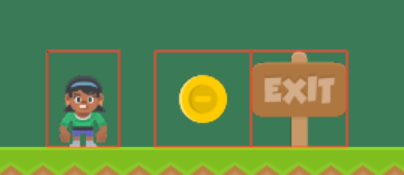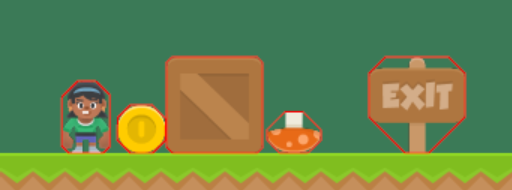Texture Management#
arcade.Texture#
- class arcade.Texture(name: str, image: Optional[PIL.Image.Image] = None, hit_box_algorithm: Optional[str] = 'Simple', hit_box_detail: float = 4.5)[source]#
Class that represents a texture. Usually created by the
load_textureorload_texturescommands.- Parameters
name (str) – Name of texture. Used for caching, so must be unique for each texture.
image (PIL.Image.Image) – Image to use as a texture.
hit_box_algorithm (str) –
One of None, ‘None’, ‘Simple’ or ‘Detailed’. Defaults to ‘Simple’. Use ‘Simple’ for the
PhysicsEngineSimple,PhysicsEnginePlatformerand ‘Detailed’ for thePymunkPhysicsEngine.
hit_box_algorithm = “None”#

hit_box_algorithm = “Simple”#

hit_box_algorithm = “Detailed”#
hit_box_detail (float) – Float, defaults to 4.5. Used with ‘Detailed’ to hit box
- Attributes:
- name
Unique name of the texture. Used by load_textures for caching. If you are manually creating a texture, you can just set this to whatever.
- image
A
PIL.Image.Imageobject.- width
Width of the texture in pixels.
- height
Height of the texture in pixels.
- size
Tuple containing (width, height)
- hit_box_points
The computed hit box of the texture
- classmethod create_empty(name: str, size: Tuple[int, int]) arcade.texture.Texture[source]#
Create a texture with all pixels set to transparent black.
The hit box of the returned Texture will be set to a rectangle with the dimensions in
sizebecause there is no non-blank pixel data to calculate a hit box.- Parameters
This function has multiple uses, including:
Allocating space in texture atlases
Generating custom cached textures from component images
The internal image can be altered with Pillow draw commands and then written/updated to a texture atlas. This works best for infrequent changes such as generating custom cached sprites. For frequent texture changes, you should instead render directly into the texture atlas.
Warning
If you plan to alter images using Pillow, read its documentation thoroughly! Some of the functions can have unexpected behavior.
For example, if you want to draw one or more images that contain transparency onto a base image that also contains transparency, you will likely need to use PIL.Image.alpha_composite as part of your solution. Otherwise, blending may behave in unexpected ways.
This is especially important for customizable characters.
Be careful of your RAM usage when using this function. The Texture this method returns will have a new internal RGBA Pillow image which uses 4 bytes for every pixel in it. This will quickly add up if you create many large Textures.
If you want to create more than one blank texture with the same dimensions, you can save CPU time and RAM by calling this function once, then passing the
imageattribute of the resulting Texture object to the class constructor for each additional blank Texture instance you would like to create. This can be especially helpful if you are creating multiple large Textures.
- classmethod create_filled(name: str, size: Tuple[int, int], color: Union[Tuple[int, int, int], List[int], Tuple[int, int, int, int]]) arcade.texture.Texture[source]#
Create a texture completely filled with the passed color.
The hit box of the returned Texture will be set to a rectangle with the dimensions in
sizebecause all pixels are filled with the same color.- Parameters
This function has multiple uses, including:
A helper for pre-blending backgrounds into terrain tiles
Fillers to stand in for state-specific textures
Quick filler assets for various proofs of concept
Be careful of your RAM usage when using this function. The Texture this method returns will have a new internal RGBA Pillow image which uses 4 bytes for every pixel in it. This will quickly add up if you create many large Textures.
If you want to create more than one filled texture with the same background color, you can save CPU time and RAM by calling this function once, then passing the
imageattribute of the resulting Texture object to the class constructor for each additional filled Texture instance you would like to create. This can be especially helpful if you are creating multiple large Textures.
- draw_scaled(center_x: float, center_y: float, scale: float = 1.0, angle: float = 0, alpha: int = 255)[source]#
Draw the texture.
arcade.cleanup_texture_cache#
arcade.load_spritesheet#
- arcade.load_spritesheet(file_name: Union[str, pathlib.Path], sprite_width: int, sprite_height: int, columns: int, count: int, margin: int = 0, hit_box_algorithm: Optional[str] = 'Simple', hit_box_detail: float = 4.5) List[arcade.texture.Texture][source]#
- Parameters
file_name (str) – Name of the file to that holds the texture.
sprite_width (int) – Width of the sprites in pixels
sprite_height (int) – Height of the sprites in pixels
columns (int) – Number of tiles wide the image is.
count (int) – Number of tiles in the image.
margin (int) – Margin between images
hit_box_algorithm (str) – One of None, ‘None’, ‘Simple’ (default) or ‘Detailed’.
hit_box_detail (float) – Float, defaults to 4.5. Used with ‘Detailed’ to hit box
- Returns List
List of
Textureobjects.
arcade.load_texture#
- arcade.load_texture(file_name: Union[str, pathlib.Path], x: float = 0, y: float = 0, width: float = 0, height: float = 0, flipped_horizontally: bool = False, flipped_vertically: bool = False, flipped_diagonally: bool = False, can_cache: bool = True, mirrored: Optional[bool] = None, hit_box_algorithm: Optional[str] = 'Simple', hit_box_detail: float = 4.5) arcade.texture.Texture[source]#
Load an image from disk and create a texture.
Note: If the code is to load only part of the image, the given x, y coordinates will start with the origin (0, 0) in the upper left of the image. When drawing, Arcade uses (0, 0) in the lower left corner. Be careful with this reversal.
For a longer explanation of why computers sometimes start in the upper left, see: http://programarcadegames.com/index.php?chapter=introduction_to_graphics&lang=en#section_5
- Parameters
file_name (str) – Name of the file to that holds the texture.
x (float) – X position of the crop area of the texture.
y (float) – Y position of the crop area of the texture.
width (float) – Width of the crop area of the texture.
height (float) – Height of the crop area of the texture.
flipped_horizontally (bool) – Mirror the sprite image. Flip left/right across vertical axis.
flipped_vertically (bool) – Flip the image up/down across the horizontal axis.
flipped_diagonally (bool) – Transpose the image, flip it across the diagonal.
can_cache (bool) – If a texture has already been loaded, load_texture will return the same texture in order to save time. Sometimes this is not desirable, as resizing a cached texture will cause all other textures to resize with it. Setting can_cache to false will prevent this issue at the experience of additional resources.
mirrored (bool) – Deprecated.
hit_box_algorithm (str) –
One of None, ‘None’, ‘Simple’ or ‘Detailed’. Defaults to ‘Simple’. Use ‘Simple’ for the
PhysicsEngineSimple,PhysicsEnginePlatformerand ‘Detailed’ for thePymunkPhysicsEngine.
hit_box_algorithm = “None”#

hit_box_algorithm = “Simple”#

hit_box_algorithm = “Detailed”#
hit_box_detail (float) – Float, defaults to 4.5. Used with ‘Detailed’ to hit box
- Returns
New
Textureobject.- Raises
ValueError
arcade.load_texture_pair#
arcade.load_textures#
- arcade.load_textures(file_name: Union[str, pathlib.Path], image_location_list: Union[Tuple[Union[Tuple[float, float, float, float], List[float]], ...], List[Union[Tuple[float, float, float, float], List[float]]]], mirrored: bool = False, flipped: bool = False, hit_box_algorithm: Optional[str] = 'Simple', hit_box_detail: float = 4.5) List[arcade.texture.Texture][source]#
Load a set of textures from a single image file.
Note: If the code is to load only part of the image, the given x, y coordinates will start with the origin (0, 0) in the upper left of the image. When drawing, Arcade uses (0, 0) in the lower left corner. Be careful with this reversal.
For a longer explanation of why computers sometimes start in the upper left, see: http://programarcadegames.com/index.php?chapter=introduction_to_graphics&lang=en#section_5
- Parameters
file_name (str) – Name of the file.
image_location_list (List) – List of image sub-locations. Each rectangle should be a List of four floats: [x, y, width, height].
mirrored (bool) – If set to True, the image is mirrored left to right.
flipped (bool) – If set to True, the image is flipped upside down.
hit_box_algorithm (str) – One of None, ‘None’, ‘Simple’ (default) or ‘Detailed’.
hit_box_detail (float) – Float, defaults to 4.5. Used with ‘Detailed’ to hit box
- Returns
List of
Texture’s.- Raises
ValueError
arcade.make_circle_texture#
arcade.make_soft_circle_texture#
- arcade.make_soft_circle_texture(diameter: int, color: Union[Tuple[int, int, int], List[int], Tuple[int, int, int, int]], center_alpha: int = 255, outer_alpha: int = 0, name: Optional[str] = None) arcade.texture.Texture[source]#
Return a
Textureof a circle with the given diameter and color, fading out at its edges.- Parameters
diameter (int) – Diameter of the circle and dimensions of the square
Texturereturned.color (Color) – Color of the circle.
center_alpha (int) – Alpha value of the circle at its center.
outer_alpha (int) – Alpha value of the circle at its edges.
name (str) – Custom or pre-chosen name for this texture
- Returns
New
Textureobject.- Return type
arcade.make_soft_square_texture#
- arcade.make_soft_square_texture(size: int, color: Union[Tuple[int, int, int], List[int], Tuple[int, int, int, int]], center_alpha: int = 255, outer_alpha: int = 0, name: Optional[str] = None) arcade.texture.Texture[source]#
Return a
Textureof a square with the given diameter and color, fading out at its edges.- Parameters
- Returns
New
Textureobject.
arcade.trim_image#
- arcade.trim_image(image: PIL.Image.Image) PIL.Image.Image[source]#
Crops the extra whitespace out of an image.
- Returns
New
PIL.Image.Imageobject.